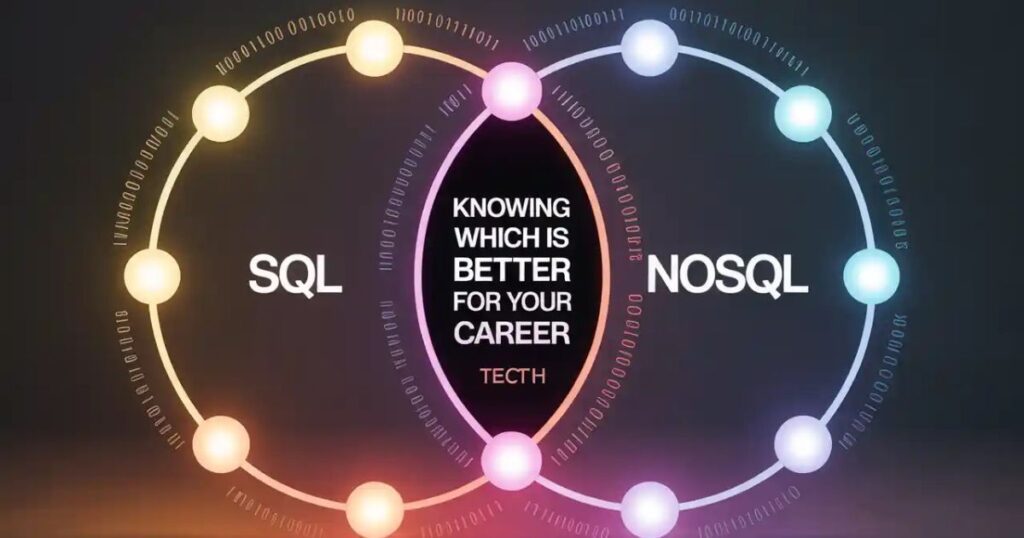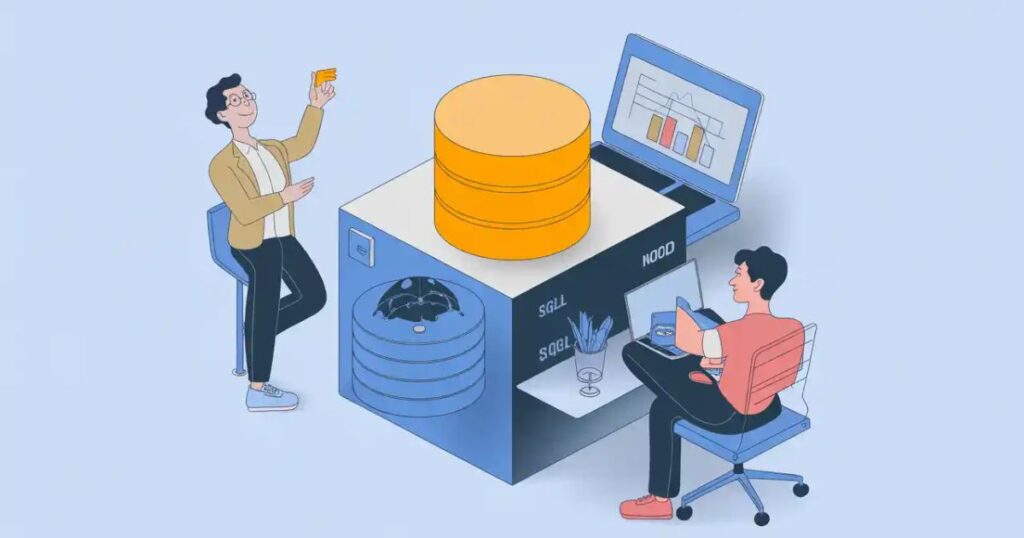One question frequently arises in the fields of SQL vs. NoSQL, particularly for professionals getting ready for tech placements, students, and novice developers:

Which is better for your application: SQL vs NoSQL?
Although this question may appear simple, it is one of the most crucial choices in creating a system that is high-performing, scalable, and maintainable. Knowing the difference between SQL and NoSQL is crucial whether you’re working with real-time data, creating a social media app, maintaining user accounts, or constructing the backend of an e-commerce business.
Everything you need to know is covered in this article, from the fundamental ideas and applications to the expectations of American businesses for entry-level IT workers in 2025.
What is SQL?
A class of relational databases known as SQL, or Structured Query Language, stores data in tables that are organized according to rows and columns. Every piece of data must adhere to a predetermined schema, thus you must choose your database’s structure before you start adding records.
Relational databases excel in preserving the consistency and integrity of data. They are perfect for systems with intricate data linkages because they support relationships between entities through primary and foreign keys. The ACID principles atomicity, consistency, isolation, and durability form the foundation of SQL databases. Because of this, they are incredibly dependable, especially when handling money transactions, inventory management systems, or any other type of vital company information.
MySQL, PostgreSQL, Oracle Database, and Microsoft SQL Server are well-known instances of SQL databases. These systems are widely used in a variety of areas, including retail, education, healthcare, and banking.
What is NoSQL?
The term “Not Only SQL,” or “NoSQL,” describes a class of databases that depart from conventional table-based structures. Rather, data can be stored in wide-column stores, graphs, JSON-like documents, or key-value pairs in NoSQL databases. They are perfect for managing unstructured or semi-structured data, like logs, user-generated material, and social media interactions, because of their versatility.

The capacity of NoSQL databases to scale horizontally is one of their main benefits. NoSQL systems disperse the data among several servers or clusters (horizontal scalability), whereas SQL systems typically scale by upgrading server hardware (vertical scaling). Because of this, NoSQL is ideally suited for large-scale, heavily trafficked online applications.
Several popular NoSQL databases are Neo4j (graph database), Cassandra (wide-column store), Redis (key-value store), and MongoDB (document store). These systems are frequently utilized in contemporary cloud-native applications, particularly those that demand high speed, flexible data models, and real-time changes.
Key Distinctions Between NoSQL and SQL
How SQL and NoSQL organize, store, and retrieve data is where they diverge most fundamentally. Structured tables are used in SQL databases, and data must follow a predetermined schema. Any modifications to this schema, like adding a new column, necessitate a migration procedure, which might take a while, particularly for big datasets. However, because NoSQL databases are schema-flexible, every record or document may have a unique structure. In agile development contexts, where the data model may change often, this is very beneficial.
Consistency and transactions are another important distinction. Strong consistency is a design feature of SQL databases. A modification to the database is instantly accessible to all users and systems that are querying the data. According to the CAP theorem, NoSQL systems frequently forgo this stringent consistency in favor of high availability and partition tolerance. Since data in the majority of NoSQL databases is eventually consistent, it could take a little while for updates to spread to every node.
The strong and standardized SQL language is used by SQL databases for querying. In contrast, NoSQL databases frequently need unique query syntax or database engine-specific APIs. For example, using the MongoDB Query Language (MQL), which is different from standard SQL commands, to query MongoDB entails creating JSON-like objects.
When to Employ SQL
When your application needs high consistency, multi-table joins, and complicated queries, SQL databases are the best option. In systems where data reliability and correctness are non-negotiable, this is usually the case.
A banking application, for instance, needs to guarantee that a financial transfer either completes completely or doesn’t occur at all. “Eventual consistency” has no place in this situation. Similarly, SQL is frequently used by customer relationship management (CRM) software, inventory management platforms, and HR systems to manage structured data with numerous linkages.

SQL is frequently a preferable option if your application will profit from sophisticated analytics, reporting, or business intelligence tools. Strong query optimization, transaction logging, and access control mechanisms all necessary in enterprise-grade settings, are supported by its well-developed ecosystem.
When to Use NoSQL
When dealing with vast amounts of unstructured data or when the data format is likely to vary over time, NoSQL databases excel. NoSQL is frequently a superior option when developing a social media feed, content management system, or real-time chat application because of its adaptability and performance in high-load situations.
Applications that must swiftly ingest and process data from several sources, including sensor data from Internet of Things devices, user interactions on a website, or streaming logs, are also a good fit for NoSQL. It’s not always feasible or effective to force all incoming data to follow a strict structure in certain situations.
NoSQL databases provide a scalable and lightweight backend that works well with contemporary tools and platforms in cloud-based and microservices architectures. Serverless apps that require low latency and worldwide availability frequently employ services like AWS DynamoDB or MongoDB Atlas.
Combining NoSQL with SQL
Known as polyglot persistence, developers and businesses are increasingly opting to employ both SQL and NoSQL in a single application. For example, SQL may be used by an e-commerce platform to manage user accounts, inventory, and orders—ensuring transactional correctness and data consistency. However, in situations when speed and flexibility are more crucial than perfect consistency, it might employ NoSQL to store user evaluations, product recommendations, or search history.
Teams may optimize for both performance and dependability by using the appropriate tool for each component of the system thanks to this hybrid approach.
What American Companies Anticipate in 2025
Hiring managers in the modern workforce, particularly in the United States, anticipate that entry-level developers will be familiar with both relational and non-relational databases. Even less experienced engineers ought to be able to distinguish between SQL and NoSQL, pinpoint suitable use cases, and exhibit rudimentary knowledge of at least one tool from each category.
Employers frequently require knowledge of MySQL or PostgreSQL when it comes to SQL. Writing simple queries, executing joins, utilizing indexes, and comprehending limitations such as main and foreign keys should all come naturally to you.
MongoDB is usually the most sought-after NoSQL talent, especially in full-stack web development. It also helps to have experience with cloud-hosted solutions like Amazon DynamoDB or Firebase.
Candidates with the ability to think critically about data architecture are highly sought after by employers. Knowing when and why to pick a specific database system is more important than simply knowing how to write a query. In an interview, you can differentiate yourself from other candidates by being able to defend your choice using criteria like consistency requirements, data volume, or performance needs.
Common Interview Questions and Their Responses
“When would you use SQL over NoSQL?” is a frequently asked interview question. A real-world example is the most effective method to respond to this question. You might say, “Since SQL has a structured schema and strong ACID compliance, I would use it if I were building a payroll system where financial accuracy is crucial.”
“What is eventual consistency?” is another frequently posed question. The data may not be instantly accessible across all database nodes following a write operation, but it will eventually become consistent. This is known as eventual consistency. Many NoSQL systems leverage this trade-off to improve performance and availability.
You might also be asked if joins are supported by NoSQL. In general, NoSQL databases, like as MongoDB, emphasize embedding related data within documents to avoid the need for joins altogether, even though they have limited join capabilities through operators like $lookup.
Another crucial prerequisite for the interview is knowledge of the CAP theorem. According to this theorem, only two of the three characteristics of a distributed database system consistency, availability, and partition tolerance can be completely guaranteed. Whereas NoSQL databases frequently prioritize availability and partition tolerance, SQL databases place a higher priority on consistency and availability.
The Last Word
The argument between NoSQL and SQL is not about which is superior; rather, it is about which is best suited to the issue at hand. While NoSQL drives some of the world’s fastest-growing apps and platforms, SQL continues to be the foundation of many enterprise and transactional systems.
You must be knowledgeable about both if you plan to pursue a career in technology today. Start by learning SQL, which will provide you with a strong foundation in relational logic, transactions, and structured data. To learn how contemporary, scalable systems are constructed, proceed to NoSQL. Gaining proficiency in both will improve your development skills and raise your marketability.
At CheckMateITTech, we assist students and professionals in their early careers in developing practical projects, gaining practical database experience, and being ready for technical interviews. You should have both SQL and NoSQL skills, and you should know when to utilize both, if you want to stand out on your next internship or placement application.
